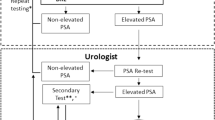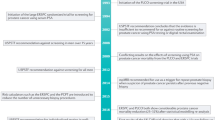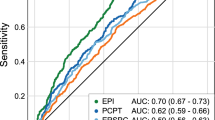Abstract
Several analyses have demonstrated a clinically useful relationship between serum prostate specific antigen (PSA) and prostate volume in men with benign prostatic hyperplasia (BPH) and lower urinary tract symptoms (LUTS). Both prostate volume and serum PSA predict certain aspects of the natural history of LUTS and BPH, and men with higher PSA and larger glands in general have a higher rate of progression measured by various parameters. Serum PSA also predicts the response to certain types of medical therapy in men with LUTS and BPH and is thus useful in the evaluation and management of these patients. Lastly, serum PSA does not loose its usefulness as a cancer marker for prostate cancer even if certain medications reduce serum PSA values predictably by 50%.
This is a preview of subscription content, access via your institution
Access options
Subscribe to this journal
Receive 8 print issues and online access
$259.00 per year
only $32.38 per issue
Buy this article
- Purchase on Springer Link
- Instant access to full article PDF
Prices may be subject to local taxes which are calculated during checkout








Similar content being viewed by others
References
Roehrborn C, McConnell J . Etiology, pathophysiology, epidemiology and natural history of benign prostatic hyperplasia. In: Walsh P, Retik A, Vaughan E, Wein A (eds). Campbell's Urology, 8th edn. Saunders: Philadelphia, 2002, pp 1297–1336.
Roehrborn CG, Girman CJ, Rhodes T, Hanson KA, Collins GN, Sech SM et al. Correlation between prostate size estimated by digital rectal examination and measured by transrectal ultrasound. Urology 1997; 49: 548–557.
Thompson IM, Pauler DK, Goodman PJ, Tangen CM, Lucia MS, Parnes HL et al. Prevalence of prostate cancer among men with a prostate-specific antigen level <or=4.0 ng per milliliter. N Engl J Med 2004; 350: 2239–2246.
Bosch JL, Tilling K, Bohnen AM, Donovan JL . Establishing normal reference ranges for PSA change with age in a population-based study: the Krimpen study. Prostate 2006; 66: 335–343.
Powell IJ, Banerjee M, Novallo M, Sakr W, Grignon D, Wood DP et al. Should the age specific prostate specific antigen cutoff for prostate biopsy be higher for black than for white men older than 50 years? J Urol 2000; 163: 146–148; discussion 148–149.
DeAntoni EP . Age-specific reference ranges for PSA in the detection of prostate cancer. Oncology (Williston Park) 1997; 11: 475–482, 485; discussion 485–476, 489.
DeAntoni EP, Crawford ED, Oesterling JE, Ross CA, Berger ER, McLeod DG et al. Age- and race-specific reference ranges for prostate-specific antigen from a large community-based study. Urology 1996; 48: 234–239.
Oesterling JE, Jacobsen SJ, Chute CG, Guess HA, Girman CJ, Panser LA et al. Serum prostate-specific antigen in a community-based population of healthy men. Establishment of age-specific reference ranges. JAMA 1993; 270: 860–864.
Roehrborn CG, Boyle P, Gould AL, Waldstreicher J . Serum prostate-specific antigen as a predictor of prostate volume in men with benign prostatic hyperplasia. Urology 1999; 53: 581–589.
Hedelin H, Johansson N, Stroberg P . Relationship between benign prostatic hyperplasia and lower urinary tract symptoms and correlation between prostate volume and serum prostate-specific antigen in clinical routine. Scand J Urol Nephrol 2005; 39: 154–159.
Hochberg DA, Armenakas NA, Fracchia JA . Relationship of prostate-specific antigen and prostate volume in patients with biopsy proven benign prostatic hyperplasia. Prostate 2000; 45: 315–319.
Hammerer PG, McNeal JE, Stamey TA . Correlation between serum prostate specific antigen levels and the volume of the individual glandular zones of the human prostate. J Urol 1995; 153: 111–114.
Yu HJ, Chiang GJ, Chiu TY, Lai MK . Relationship between serum prostate specific antigen concentration and prostate volume. J Formos Med Assoc 1995; 94: 666–670.
Bosch JL, Hop WC, Bangma CH, Kirkels WJ, Schroder FH . Prostate specific antigen in a community-based sample of men without prostate cancer: correlations with prostate volume, age, body mass index, and symptoms of prostatism. Prostate 1995; 27: 241–249.
Rhodes T, Girman CJ, Jacobsen SJ, Roberts RO, Guess HA, Lieber MM . Longitudinal prostate growth rates during 5 years in randomly selected community men 40–79 years old. J Urol 1999; 161: 1174–1179.
Jacobsen SJ, Jacobson DJ, Rohe DE, Girman CJ, Roberts RO, Lieber MM . Frequency of sexual activity and prostatic health: fact or fairy tale? Urology 2003; 61: 348–353.
McConnell J, Roehrborn C, Bautista O, Andriole Jr GL, Dixon C, Kusek J et al. The long-term effects of doxazosin, finasteride and the combination on the clinical progression of benign prostatic hyperplasia. NEJM 2003; 349: 2385–2396.
Roehrborn CG, McConnell JD, Bonilla J, Rosenblatt S, Hudson PB, Malek GH et al. Serum prostate specific antigen and prostate volume predict long-term changes in symptom and flow rate: results of a four-year randomized trial comparing finasteride versus placebo. Urology 1999.
Djavan B, Fong YK, Harik M, Milani S, Reissigl A, Chaudry A et al. Longitudinal study of men with mild symptoms of bladder outlet obstruction treated with watchful waiting for four years. Urology 2004; 64: 1144–1148.
Crawford ED, Wilson SS, McConnell JD, Slawin KM, Lieber MC, Smith JA et al. Baseline factors as predictors of clinical progression of benign prostatic hyperplasia in men treated with placebo. J Urol 2006; 175: 1422–1426; discussion 1426–1427.
Bruskewitz R, Girman CJ, Fowler J, Rigby OF, Sullivan M, Bracken RB et al. Effect of finasteride on bother and other health-related quality of life aspects associated with benign prostatic hyperplasia. PLESS Study Group. Proscar Long-term Efficacy and Safety Study. Urology 1999; 54: 670–678.
Roehrborn CG, McConnell JD, Lieber M, Kaplan S, Geller J, Malek GH et al. Serum prostate-specific antigen concentration is a powerful predictor of acute urinary retention and need for surgery in men with clinical benign prostatic hyperplasia. PLESS Study Group. Urology 1999; 53: 473–480.
Roehrborn CG, Marks LS, Fenter T, Freedman S, Tuttle J, Gittleman M et al. Efficacy and safety of dutasteride in the four-year treatment of men with benign prostatic hyperplasia. Urology 2004; 63: 709–715.
Roehrborn CG, Boyle P, Nickel JC, Hoefner K, Andriole G . Efficacy and safety of a dual inhibitor of 5-alpha-reductase types 1 and 2 (dutasteride) in men with benign prostatic hyperplasia. Urology 2002; 60: 434–441.
Jacobsen SJ, Jacobson DJ, Girman CJ, Roberts RO, Rhodes T, Guess HA et al. Treatment for benign prostatic hyperplasia among community dwelling men: the Olmsted County study of urinary symptoms and health status. J Urol 1999; 162: 1301–1306.
Kaplan S, Garvin D, Gilhooly P, Koppel M, Labasky R, Milsten R et al. Impact of baseline symptom severity on future risk of benign prostatic hyperplasia-related outcomes and long-term response to finasteride. The Pless Study Group. Urology 2000; 56: 610–616.
Kaplan SA, Holtgrewe HL, Bruskewitz R, Saltzman B, Mobley D, Narayan P et al. Comparison of the efficacy and safety of finasteride in older versus younger men with benign prostatic hyperplasia. Urology 2001; 57: 1073–1077.
Milani S, Djavan B . Lower urinary tract symptoms suggestive of benign prostatic hyperplasia: latest update on alpha-adrenoceptor antagonists. BJU Int 2005; 95 (Suppl 4): 29–36.
Roehrborn CG, Schwinn DA . Alpha1-adrenergic receptors and their inhibitors in lower urinary tract symptoms and benign prostatic hyperplasia. J Urol 2004; 171: 1029–1035.
Roehrborn CG, McConnell JD, Saltzman B, Bergner D, Gray T, Narayan P et al. Storage (irritative) and voiding (obstructive) symptoms as predictors of benign prostatic hyperplasia progression and related outcomes. Eur Urol 2002; 42: 1–6.
Roehrborn CG, Van Kerrebroeck P, Nordling J . Safety and efficacy of alfuzosin 10 mg once-daily in the treatment of lower urinary tract symptoms and clinical benign prostatic hyperplasia: a pooled analysis of three double-blind, placebo-controlled studies. BJU Int 2003; 92: 257–261.
Roehrborn CG . Three months’ treatment with the alpha1-blocker alfuzosin does not affect total or transition zone volume of the prostate. Prostate Cancer Prostatic dis 2006; 9: 121–125.
Lepor H, Williford WO, Barry MJ, Brawer MK, Dixon CM, Gormley G et al. The efficacy of terazosin, finasteride, or both in benign prostatic hyperplasia. Veterans Affairs Cooperative Studies Benign Prostatic Hyperplasia Study Group. N Engl J Med 1996; 335: 533–539.
Roehrborn CG, McConnell JDM et al. Baseline prostate volume and serum PSA predict rate of prostate growth: analysis from the MTOPS data. J Urol 2003; 169 (Suppl 4): 364.
Lowe FC, McConnell JD, Hudson PB, Romas NA, Boake R, Lieber M et al. Long-term 6-year experience with finasteride in patients with benign prostatic hyperplasia. Urology 2003; 61: 791–796.
Boyle P, Robertson C, Manski R, Padley RJ, Roehrborn CG . Meta-analysis of randomized trials of terazosin in the treatment of benign prostatic hyperplasia. Urology 2001; 58: 717–722.
Roehrborn CG . Alfuzosin 10 mg once daily prevents overall clinical progression of benign prostatic hyperplasia but not acute urinary retention: results of a 2-year placebo-controlled study. BJU Int 2006; 97: 734–741.
Boyle P, Gould AL, Roehrborn CG . Prostate volume predicts outcome of treatment of benign prostatic hyperplasia with finasteride: meta-analysis of randomized clinical trials. Urology 1996; 48: 398–405.
Boyle P, Roehrborn C, Gould L . Baseline serum PSA levels predict degree of symptom improvement following therapy of BPH with finasteride. J Urol 1997; 157: 134A.
McConnell JD, Roehrborn CG, Bautista OM, Andriole Jr GL, Dixon CM, Kusek JW et al. The long-term effect of doxazosin, finasteride, and combination therapy on the clinical progression of benign prostatic hyperplasia. N Engl J Med 2003; 349: 2387–2398.
Boyle P, Roehrborn C, Harkaway R, Logie J, de la Rosette J, Emberton M . 5-Alpha reductase inhibition provides superior benefits to alpha blockade by preventing AUR and BPH-related surgery. Eur Urol 2004; 45: 620–626; discussion 626–627.
Roehrborn C, Bruskewitz R, Nickel GC, Glickman S, Cox C, Anderson R et al. Urinary retention in patients with BPH treated with finasteride or placebo over four years: characterization of patients and ultimate outcomes. The PLESS Study Group. Eur Urol 2000; 37: 528–536.
Roehrborn CG, Oesterling JE, Olson PJ, Padley RJ, Group HI . Serial prostate-specific antigen measurements in men with clinically benign prostatic hyperplasia during a 12-months placebo-controlled study with terazosin. Urology 1997; 50: 556–561.
Kirby RS, Roehrborn C, Boyle P, Bartsch G, Jardin A, Cary MM et al. Efficacy and tolerability of doxazosin and finasteride, alone or in combination, in treatment of symptomatic benign prostatic hyperplasia: the Prospective European Doxazosin and Combination Therapy (PREDICT) trial. Urology 2003; 61: 119–126.
Roehrborn C, Andriole G, Boyle P, Hofner K . Effect of the dual 5 alpha reductase inhibitor dutasteride on endocrine parameters and prostate volume. Eur Urol 2002; 1 (Suppl 1): 107.
Gormley GJ, Stoner E, Bruskewitz RC, Imperato-McGinley J, Walsh PC, McConnell JD et al. The effect of finasteride in men with benign prostatic hyperplasia. The Finasteride Study Group. N Engl J Med 1992; 327: 1185–1191.
Brawer MK, Lin DW, Williford WO, Jones K, Lepor H . Effect of finasteride and/or terazosin on serum PSA: results of VA Cooperative Study #359. Prostate 1999; 39: 234–239.
Thompson IM, Chi C, Ankerst DP, Goodman PJ, Tangen CM, Lippman SM et al. Effect of finasteride on the sensitivity of PSA for detecting prostate cancer. J Natl Cancer Inst 2006; 98: 1128–1133.
Andriole GL, Roehrborn C, Schulman C, Slawin KM, Somerville M, Rittmaster RS . Effect of dutasteride on the detection of prostate cancer in men with benign prostatic hyperplasia. Urology 2004; 64: 537–541; discussion 542–533.
Andriole GL, Marberger M, Roehrborn CG . Clinical usefulness of serum prostate specific antigen for the detection of prostate cancer is preserved in men receiving the dual 5 alpha-reductase inhibitor dutasteride. J Urol 2006; 175: 1657–1662.
Marks LS, Andriole GL, Fitzpatrick JM, Schulman CC, Roehrborn CG . The interpretation of serum prostate specific antigen in men receiving 5alpha-reductase inhibitors: a review and clinical recommendations. J Urol 2006; 176: 868–874.
Author information
Authors and Affiliations
Corresponding author
Rights and permissions
About this article
Cite this article
Roehrborn, C. The utility of serum prostatic-specific antigen in the management of men with benign prostatic hyperplasia. Int J Impot Res 20 (Suppl 3), S19–S26 (2008). https://doi.org/10.1038/ijir.2008.53
Published:
Issue Date:
DOI: https://doi.org/10.1038/ijir.2008.53
This article is cited by
-
Estrogen and G protein-coupled estrogen receptor accelerate the progression of benign prostatic hyperplasia by inducing prostatic fibrosis
Cell Death & Disease (2022)
-
Medications and Surgical Interventions for Benign Prostatic Hyperplasia Are Potential Confounders of Prostate-Specific Antigen
Current Urology Reports (2010)
-
Validated questionnaires for assessing sexual dysfunction and BPH/LUTS: solidifying the common pathophysiologic link
International Journal of Impotence Research (2008)



